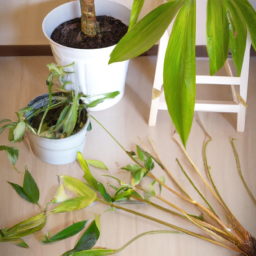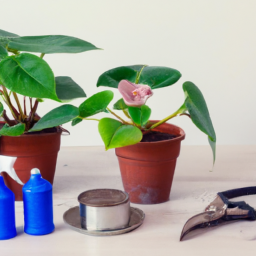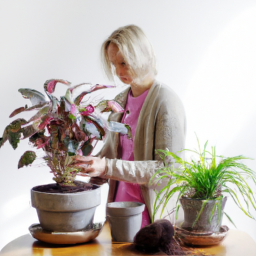
So you’ve just brought home a beautiful new indoor plant, but now you’re wondering, “Should I repot indoor plants after buying?” It’s a common question that many plant owners face, and the answer isn’t always straightforward. In this blog post, we’ll explore the benefits and potential drawbacks of repotting newly purchased indoor plants, as well as provide some tips on how to determine if your plant needs a new home. Whether you’re a seasoned plant parent or new to the world of indoor gardening, this post will help you make an informed decision about whether or not to repot your new green friend.
Signs Your Indoor Plant Needs Repotting
Yellowing or Dropping Leaves
When you notice that your indoor plant’s leaves are turning yellow or dropping off, it could be a sign that it is time to repot. This could indicate that the plant has outgrown its current pot and is not receiving enough nutrients or space to thrive. Repotting the plant into a larger container will give its roots more room to spread out and absorb nutrients, ultimately leading to healthier foliage.
In some cases, yellowing or dropping leaves could also be a sign of overwatering or poor drainage in the current pot. Repotting the plant into a pot with better drainage can help prevent root rot and other issues that may be causing the leaves to yellow or drop.
Roots Growing Out of Drainage Holes
Another clear sign that your indoor plant needs repotting is when you see roots growing out of the drainage holes at the bottom of the pot. This indicates that the plant has become root-bound and is in desperate need of more space to grow. If left unaddressed, the roots may become tangled and compacted, leading to poor nutrient absorption and stunted growth.
When repotting a plant with roots growing out of the drainage holes, gently loosen the roots and transplant the plant into a larger pot with fresh soil. This will give the roots room to spread out and establish themselves in the new container, promoting healthier growth and overall plant health.
Slow Growth or Wilting
If you notice that your indoor plant is growing slowly or wilting despite regular watering and care, it may be time to repot. Slow growth or wilting can be a sign that the plant is not getting enough nutrients or space to thrive in its current pot. Repotting the plant into a larger container with fresh soil will provide the roots with more room to grow and access to the nutrients they need to support healthy growth.
In some cases, slow growth or wilting may also be a sign of root rot or other issues related to poor drainage in the current pot. Repotting the plant into a pot with better drainage can help prevent these issues and promote healthier growth in the long run.
By paying attention to these signs and taking action when necessary, you can ensure that your indoor plants have the best chance of thriving and flourishing in your home. Repotting may seem like a daunting task, but the benefits of providing your plants with the right environment to grow and thrive are well worth the effort.

Benefits of Repotting Indoor Plants After Purchase
Improved Plant Health
When you bring home a new indoor plant, it’s important to consider repotting it for the health of the plant. Many plants are sold in containers that are too small for their root systems, which can lead to root bound plants. When a plant becomes root bound, its roots become tangled and compacted, which can restrict the plant’s ability to absorb nutrients and water. By repotting your indoor plants after purchase, you can give them the space they need to grow healthy roots and thrive.
In addition to preventing root bound plants, repotting can also help you identify and address any issues with the plant’s roots. When you remove the plant from its original container, take the time to carefully inspect the roots for any signs of rot or disease. By catching these issues early, you can take steps to treat the plant and prevent further damage.
Repotting your indoor plants can also help improve their overall health by providing them with fresh, nutrient-rich soil. Over time, the soil in a plant’s original container can become depleted of nutrients, which can impact the plant’s growth and vitality. By repotting your indoor plants with fresh soil, you can ensure that they have access to the nutrients they need to thrive.
Encourages Growth and Blooming
Repotting your indoor plants after purchase can also encourage growth and blooming. When a plant is root bound, its roots are unable to expand and grow, which can stunt the plant’s overall growth. By repotting your indoor plants in a larger container, you can give them the space they need to develop a healthy root system, which can in turn promote new growth and blooming.
In addition to providing more room for root growth, repotting your indoor plants can also help improve the plant’s overall health, which can lead to more vigorous growth and blooming. By giving your indoor plants fresh soil and room to grow, you can help them reach their full potential and produce beautiful blooms.
It’s important to note that not all indoor plants need to be repotted immediately after purchase. Some plants may be perfectly happy in their original containers for a while. However, if you notice signs of root bound plants, such as roots growing out of the drainage holes or circling around the inside of the container, it may be time to consider repotting.
Prevents Overcrowding and Competition
Another benefit of repotting indoor plants after purchase is that it can help prevent overcrowding and competition among plants. When plants are kept in containers that are too small, they can become crowded and compete for resources such as water, nutrients, and sunlight. This competition can lead to stress and stunted growth for the plants involved.
By repotting your indoor plants in larger containers, you can give each plant the space it needs to grow and thrive without competing with other plants. This can help reduce stress and promote healthy growth for all of your indoor plants.
In addition to preventing overcrowding, repotting your indoor plants can also help you arrange them in a more aesthetically pleasing way. By choosing containers of different sizes and shapes, you can create a visually appealing display that showcases each plant’s unique beauty.
In conclusion, repotting your indoor plants after purchase can have numerous benefits for the health and growth of your plants. By providing them with fresh soil, room to grow, and space to thrive, you can help your indoor plants reach their full potential and enhance the beauty of your home. So next time you bring home a new plant, consider repotting it to give it the best possible start.

Should I Repot Indoor Plants After Buying
Hello plant lovers! So you’ve just brought home a new indoor plant and you’re wondering if you should repot it after buying. Well, the answer isn’t always a simple yes or no. There are several factors to consider before deciding whether or not to repot your new green friend. Let’s dive into the details and help you make an informed decision.
Inspect the Plant
Before making any decisions about repotting your new indoor plant, take a close look at its current condition. Check for any signs of distress such as yellowing leaves, root bound roots, or pests. If the plant looks healthy and happy in its current pot, there may be no immediate need to repot.
On the other hand, if you notice any issues like root rot or overcrowded roots, it may be best to repot the plant as soon as possible. Repotting can help refresh the soil, provide more space for the roots to grow, and prevent further damage to the plant.
Remember, each plant is unique, so it’s essential to assess its individual needs before deciding whether or not to repot.
Consider the Potting Mix
Another crucial factor to consider when deciding whether to repot your indoor plant is the quality of the potting mix it’s currently in. Some plants come in generic potting soil that may not provide the right nutrients or drainage for optimal growth.
If you notice that the soil is compacted, doesn’t drain well, or lacks essential nutrients, it may be a good idea to repot the plant in a high-quality potting mix. This will help ensure that your plant has the best possible growing conditions and can thrive in its new home.
Remember to choose a potting mix that is suitable for your specific type of plant, as different plants have different soil requirements. Research the best potting mix for your plant species to ensure its long-term health and happiness.
Choose the Right Pot
When repotting your indoor plant, it’s essential to choose the right pot size and type. A pot that is too small can restrict root growth and lead to root bound plants, while a pot that is too large can cause overwatering and root rot.
Choose a pot that is slightly larger than the current one, allowing room for the roots to grow while still providing a snug fit. Make sure the pot has drainage holes to prevent water from pooling at the bottom, which can lead to root rot.
Additionally, consider the material of the pot. Terracotta pots are porous and allow for better airflow to the roots, while plastic pots retain moisture better. Choose a pot material that suits your plant’s watering needs and growing conditions.
By following these steps and considering the individual needs of your indoor plant, you can make an informed decision about whether or not to repot after buying. Remember, repotting can help your plant thrive, but it’s essential to do so carefully and thoughtfully to ensure its long-term health and happiness.
Highlights of this article
When you bring a new indoor plant home, you may be wondering if you should repot it right away. While it may be tempting to give your new plant a fresh start in a new pot, it’s not always necessary. Most indoor plants can thrive in their original pots for a while, as long as they have enough room to grow and their current soil is still healthy.
If your plant is root-bound, meaning its roots are circling the bottom of the pot or growing out of the drainage holes, it may be time to repot. Additionally, if the soil is compacted or water isn’t draining properly, repotting could help improve the plant’s overall health. However, if your plant seems happy and healthy in its current pot, there’s no need to rush into repotting. Just keep an eye on its growth and health, and make the decision to repot based on its specific needs.
Here are this week’s Top Questions and Answers
Q1: Why should I repot indoor plants after buying them?
A1: Repotting indoor plants after buying them allows you to inspect the roots, check for any signs of pests or diseases, and provide fresh soil for optimal growth. It also gives the plant more room to grow and thrive in its new environment.
Q2: When is the best time to repot indoor plants after buying them?
A2: The best time to repot indoor plants after buying them is typically within a week or two of bringing them home. This allows the plant to acclimate to its new surroundings before being disturbed by repotting.
Q3: How do I know if my indoor plant needs to be repotted after buying?
A3: Signs that your indoor plant may need to be repotted after buying include roots growing out of the drainage holes, the plant becoming root-bound, or the soil drying out quickly. Additionally, if the plant is not thriving or showing signs of stress, it may benefit from being repotted.
Q4: What type of potting mix should I use when repotting indoor plants after buying?
A4: When repotting indoor plants after buying, it is best to use a high-quality potting mix specifically designed for the type of plant you have. Different plants have different soil requirements, so be sure to choose a mix that is suitable for your plant’s needs.
Q5: How can I safely repot indoor plants after buying without causing damage?
A5: To safely repot indoor plants after buying, gently remove the plant from its current pot, loosen the roots, and place it in a slightly larger pot with fresh soil. Be careful not to damage the roots or disturb the plant too much. Water the plant thoroughly after repotting to help it settle into its new home.

James Wong is a renowned ethnobotanist, plant scientist, and local television presenter. With a passion for demystifying plant science, he is known for translating complex botanical concepts into practical advice for everyday plant enthusiasts. James’s expertise spans from traditional gardening to cutting-edge plant technologies, making his insights accessible and informative.


